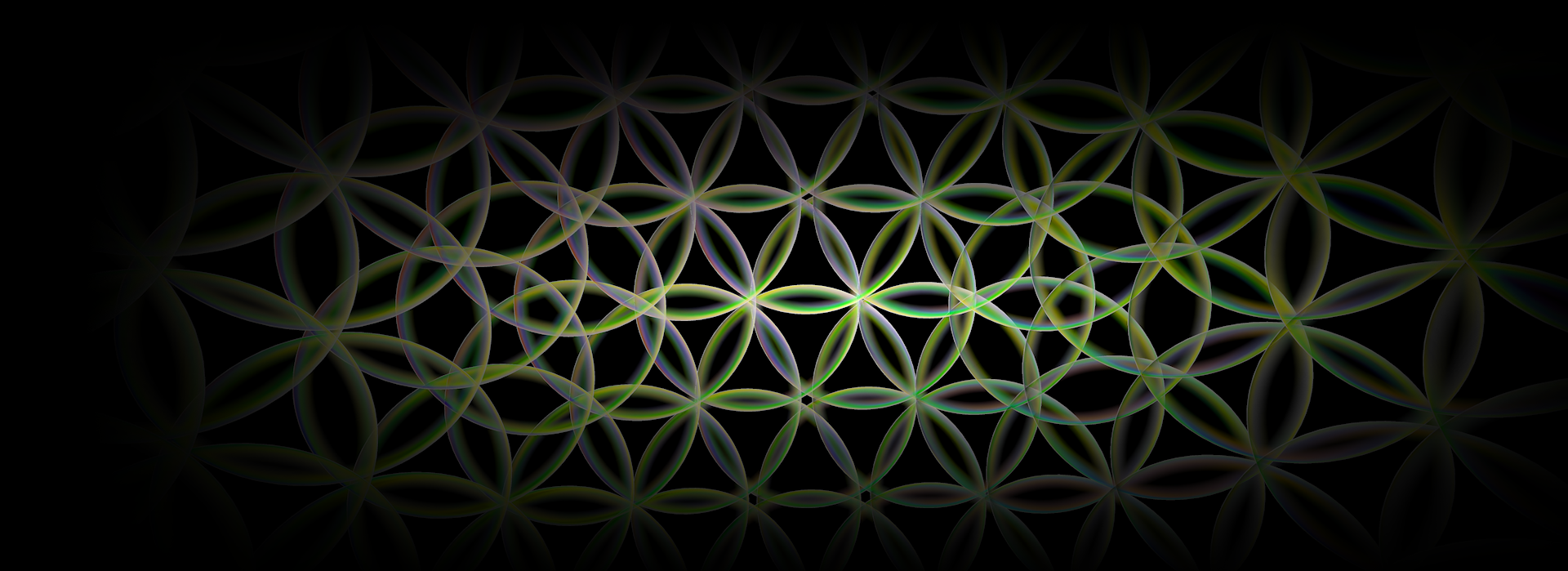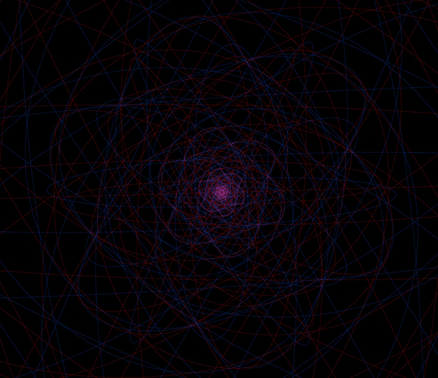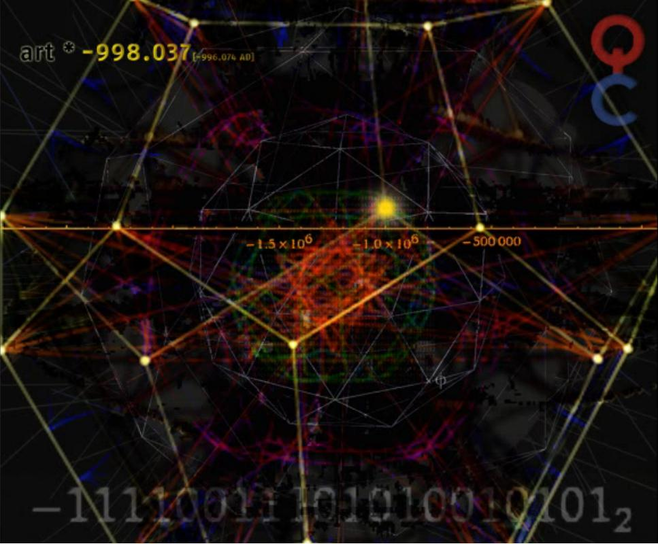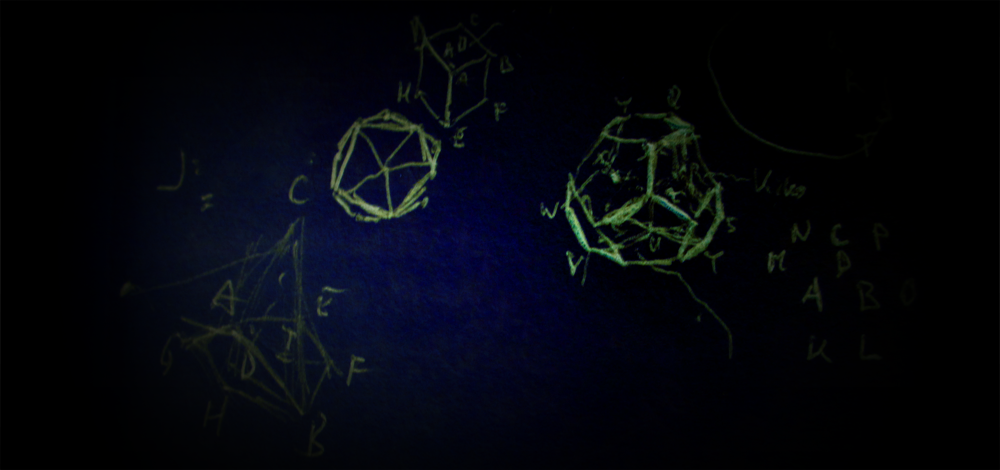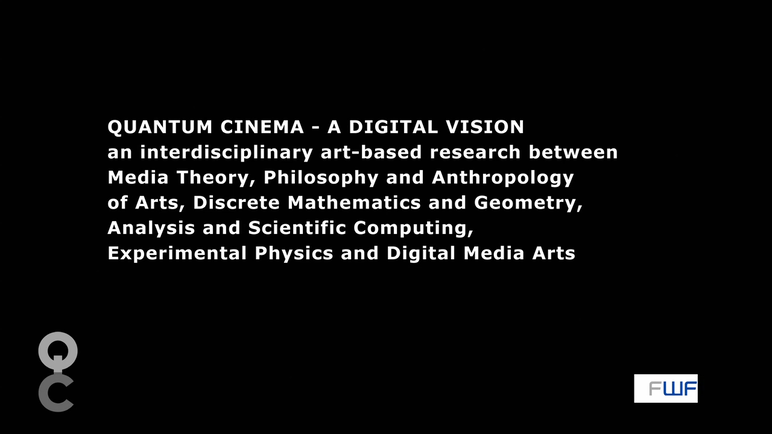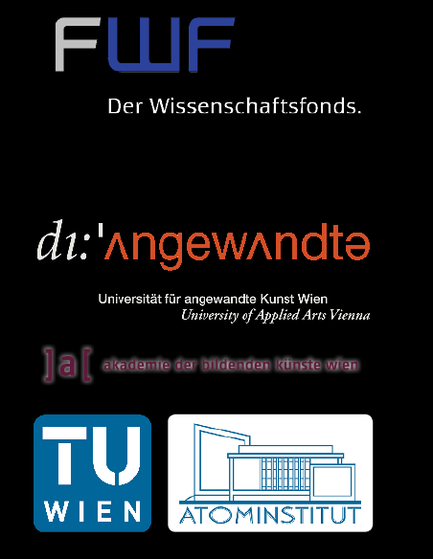Live Performance of the sound artist and violonist Mia Zabelka
The Live Stream from 11.05 to 12.00 pm on tuesday 17th of January 2012 was broadcasted at the Austrian Radio 1 (Ö1) KUNSTRADIO, Sun, 22nd, Jan. 2012
How can we transform Quantum Mechanics
into a Virtual Reality?
The complex space configuration, worked out in 3D animation, is based on the principle of the Riemann sphere used in mathematics, named after 19th century mathematician Bernhard Riemann. It is the fundamental example of a complex manifold, projective space, and algebraic variety, ubiquitous in projective geometry and algebraic geometry.
Usually, the Riemann sphere can be visualized as the unit sphere in the three-dimensional real space, and it is mapped onto the complex plane by the stereographic projection.
The challenge of the Quantum Cinema project is based on the idea, this projection must not remain restricted to the 2D medium of a plane page of paper,- merely remain a shadow of complex number space on the plane, - but needs a spatial extension of the Riemann sphere- 2D depiction model into a new digital representionform adaequate to the complex Minkowsi-space and with applicable n- vector-priciples also in corresponence to Hilbert-space.
Via the advantage of digital 3D animation, it becomes achievable to depict it within a space- animation, where the imaginative part becomes and virtually “real” and visually accessible.
Research Fields
- Experimental Physics
- Discrete Mathematics and Geometry
- Analysis und Scientific Computing
- Endophysics and Chaos Theory
A New Digital 3-D Dynamic Geometry for the Visualization of Unitary Structures
The ongoing artistic research accompanied by scientific expertise follows the current claim for a coherent picture of the quantum world and to approach it by geometry as an item of art – in this case, digital new-media art.
The QUANTUM CINEMA Team
Head
O. Univ.-Prof Dr. h. c. Peter Weibel
Universität für angewandte Kunst Wien, Institut für Medientheorie
with various scientists:
O. Univ. Prof. Mag. Dr. Elisabeth von Samsonow
Akademie der bildenden Künste Wien, Institut für Anthropologie der Künste
O. Prof. Dr. h.c. Dr. phil. Mag. rer. nat. Prof. Hellmuth Stachel
TU Wien, Institut für Diskrete Mathematik und Geometrie
Em. O. Univ. Prof. Dipl.-Ing. Dr. techn. Helmut Rauch
TU Wien, Fakultät für Physik | Atominstitut der österreichischen Universitäten
Ao. Univ. Prof. Dipl.-Ing. Dr. techn. Martin Blümlinger
TU Wien, Institut für Analysis und Scientific Computing
International Cooperations:
Prof. Dr. Otto E. Rössler
Chaosforscher, Theoretische Biochemie, Universität Tübingen
Prof. Dr. Siegfried Zielinski
Universität der Künste Berlin, Institut für Medientheorie
Prof. Dr. Peter Sloterdijk
Staatliche Hochschule für Gestaltung Karlsruhe,
Institiut für Philosophie und Ästhetik
Artistic Supervision:
VL Mag. art. Michael Huber
Universität für angewandte Kunst Wien,
Institut für Bildende und Mediale Kunst, Institut für Design
3D-Animations by Students of the Universität für angewandte Kunst Wien
Class Digitale Kunst, Univ. Prof. Mag. art. Ruth Schnell
and Art & Science, Univ. Prof. Virgil Widrich
Nikola Tasic
Merlin Wyschka
Rudi Friemel, BA
Christian Magnes
Dipl. Ing. Dr. Hans Katzgraber
Joseph Knierzinger
Additional teammembers:
Dr. Michael Schreiber
Franz Ablinger
Malte Fiala
Susanna Gartner
Kathrin Stumreich
Funded by the Austrian Science Fund FWF :: PEEK - Program for Artistic Research
The Quantum Cinema Project is reuniting Art and Science by following the claim for a coherent picture of the Quantum World, approaching it by geometric means as an item of art – in this case: Digital New-Media art.
The computer is the essential medium for the simulation,
that is for the emulation of processes for simulation within a model.
Peter Weibel
Public Work by QUANTUM CINEMA
Akademie Schloss Solitude
Artistic Research as Aesthetic Science?
Workshop, September 24/25, 2010
In the context of the art, science & business program of the Akademie Schloss Solitude, Stuttgart, in cooperation with the Zeppelin University, Friedrichshafen and with the financial support of the Wüstenrot Stiftung, Ludwigsburg.
Neues Museum Weimar
„Vision. Das Sehen“
showing <QUANTUMCINEMA – Beyond the Visible / jenseits des Sichtbaren>.
Opening: August 21, 2011, 3 p.m.
Artists: Renate Quehenberger, Nikola Tasic, Rudi Friemel, Merlin Wyschka, Joseph Knierzinger, Christian Magnes, Dr. Dipl.Ing.Hans Katzgraber.
ARTs Birthday
< Audible unitary Structures >
QC’s ARTs Birthday 2012 contribution:
a sound collage of
Field Recordings by Kathrin Stumreich
Image generated sounds by Rudi Friemel
QC_QUANTUM_FLUXUS_DADA_DUETT
lyrics: Renate Quehenberger with Peter Weibel and Erwin Schrödinger (from his talk ” Do Electrons think ?” by courtesy of Mrs. Ruth Braunitzer-Schrödinger)
This artistic research on scientific preliminaries is trying to achieve a coherent picture by designing “images“ in discrete geometry to piece the puzzle together and create a comprehensive and differentiated picture.
Hence, the artistic investigation asks the “forbidden“ question: How does it look like?
Questions about the imagination of the non-imaginative:
- How can we imagine space-time in its quantized form with its elementary forces interacting within this structure that allows the emergence of particles?
- How can we imagine the configuration space, which has as many times three dimensions as there are parts in the system?
- What is the underlying principle of the phenomenon of light in its dual form as wave and particle and what role does “entanglement” play?
- What is the nature of the “hidden parameter”?
The artistic research is accompanied by
detailed studies in all required fields:
Research on geometry and different depiction models of higher-dimensional space used in particle physicsis are the targets in QCs union of discrete mathematics and geometry, experimental quantum-physics and anthropology of art.
Media theory supervises this variantologic approach for a profound investigation by asking about analogies between imagination and media technology, as well as about depiction forms analogous to recognition and vice versa.
Research
The Quantum Cinema artistic research examines the question about space geometry on Plack scale, where quantum mechanics applied on space itself will lead to a discrete amount of quantum states, similar to traces of an electron within an atom.
Its goal is to find clues for depiction of space and time at the quantum level.
The challenge of the Quantum Cinema project is based on the idea that this projection must not remain restricted to the 2D medium of the plane of a page of paper- merely remain a shadow of complex number space on the plane – but needs a spatial extension of the Riemann sphere- 2D depiction model into a new digital representation form adequate to the complex Minkowsi-space and with applicable n-vector-principles also in correspondence to Hilbert-space. Via the advantage of digital 3D animation, it becomes achievable to depict it within a space-animation, where the imaginative part becomes as it were “real” and, virtually, visually accessible.

